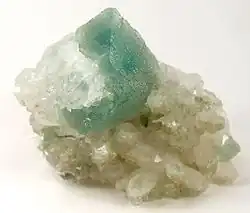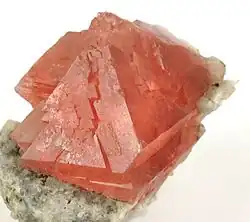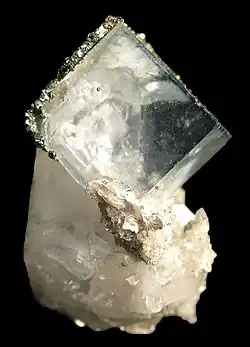Geominerals/Halogens
Halogens are elements in column 7A of the periodic table. They occur as a principal component in a variety of minerals.
Impurities can give color. Some halogen minerals are called halides.
Acuminites
Acuminite (IMA symbol: Acu[1]) is a rare halide mineral of with chemical formula: SrAlF
4(OH)·(H
2O). Its name comes from the Latin word acumen, meaning "spear point". Its Mohs scale of mineral hardness rating is 3.5.
Acumenite has only been described from its type locality of the cryolite deposit in Ivigtut, Greenland.[2]
Bromyrites
Bromyrite, or bromargyrite, is a cubic silver bromide mineral (AgBr) that is 50 at % bromine.
The image on the right shows a butterscotch colored bromargyrite cube from Broken Hill, New South Wales, Australia.
Cryolites

Cryolite (Na3AlF6) is 60 % fluorine. It occurs on Earth primarily in pegmatites.
Fluorapatites


Fluorapatite a sample of which is shown at right is a mineral with the formula Ca5(PO4)3F (calcium fluorophosphate). Fluorapatite as a mineral is the most common phosphate mineral. It occurs widely as an accessory mineral in igneous rocks and in calcium rich metamorphic rocks. It commonly occurs as a detrital or diagenic mineral in sedimentary rocks and is an essential component of phosphorite ore deposits. It occurs as a residual mineral in lateritic soils.[3]
At left is another fluorapatite example that is violet in color on quartz crystals.
Fluorites





In terms of atomic percent, fluorite (CaF2) is 66.7 % fluorine. It occurs on Earth usually as a hydrothermal deposit.
"Fluorite occurs in blue, purple, white, yellow, and colorless varieties. From field relationships the crystallization order was determined to have been blue and purple fluorite, which are commonly interlayered, followed by white, and finally yellow and colorless varieties."[4]
"Throughout most of the fluorite zone purple is the dominant, and commonly the only, color exhibited by fluorite, but in the central parts of the field green fluorite is quantitatively important, whereas at the edges of zone the fluorite is amber in color."[5]
Fourth down on the left is a crystal of rare black fluorite.
Halites
USGOV.jpg)
Halite is probably the most common mineral containing chlorine at 50 at %. It is a cubic mineral usually found in arid locations on Earth. Occurrences have clear, white, purple, blue, yellow,green, orange, and red varieties.
Iodyrites
Iodyrite (AgI) may be the most common mineral with large amounts of iodine found on Earth. It is 50 at % iodine.
On the right are twinned iodyrite, or iodargyrite, crystals are within a rock sample from Schöne Aussicht Mine, Dernbach, Neuwied, Wied Iron Spar District, Westerwald, Rhineland-Palatinate, Germany.
Tysonites
Tysonite, or fluocerite, is a lanthanide fluoride, usually CeF
3, for 75 atomic percent fluorine. It occurs in pegmatites on Earth.
Uraninites
All of the known isotopes of astatine are very short-lived. It occurs naturally in minerals such as uraninite as a decay product of uranium.
Hypotheses
- Variations in rocks from one mineral composition into another can occur with each rock type.
- Oxidanes that are various ices may be produced by orbital cycling.
See also
References
- ↑ Warr, L.N. (2021). "IMA-CNMNC approved mineral symbols". Mineralogical Magazine 85: 291-320. https://www.cambridge.org/core/journals/mineralogical-magazine/article/imacnmnc-approved-mineral-symbols/62311F45ED37831D78603C6E6B25EE0A.
- ↑ Handbook of Mineralogy
- ↑ http://rruff.geo.arizona.edu/doclib/hom/fluorapatite.pdf Mineral Handbook
- ↑ David A. S. Palmer and Anthony E. Williams-Jones (1 August 1996). "Genesis of the carbonatite-hosted fluorite deposit at Amba Dongar, India; evidence from fluid inclusions, stability isotopes, and whole rock-mineral geochemistry". Economic Geology 91 (5): 934-50. doi:10.2113/gsecongeo.91.5.934. http://www.researchgate.net/profile/Anthony_Williams-Jones/publication/235451415_Genesis_of_the_carbonatite-hosted_fluorite_deposit_at_Amba_Dongar_India_evidence_from_fluid_inclusions_stability_isotopes_and_whole_rock-mineral_geochemistry/links/54ceb1170cf29ca810fcad30.pdf. Retrieved 2015-07-27.
- ↑ F. J. Sawkins (1 March 1966). "Ore genesis in the North Pennine orefield, in the light of fluid inclusion studies". Economic Geology 61 (2): 385-401. doi:10.2113/gsecongeo.61.2.385. http://economicgeology.org/content/61/2/385.short. Retrieved 2015-07-27.